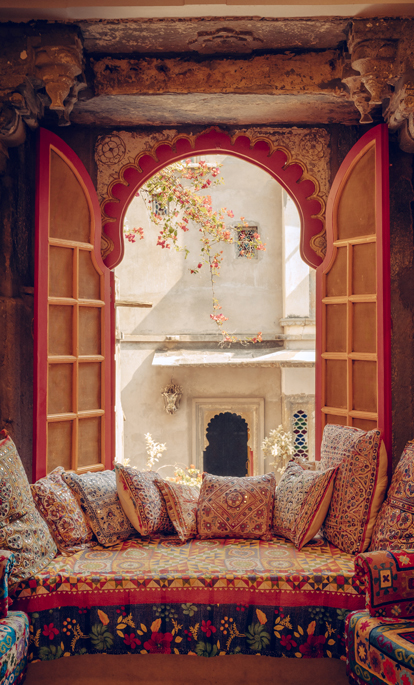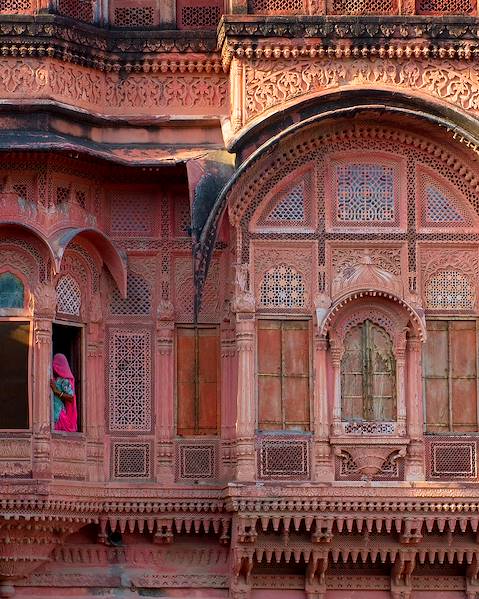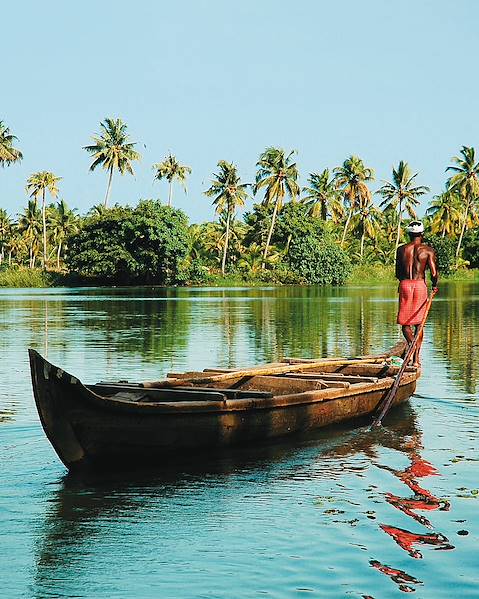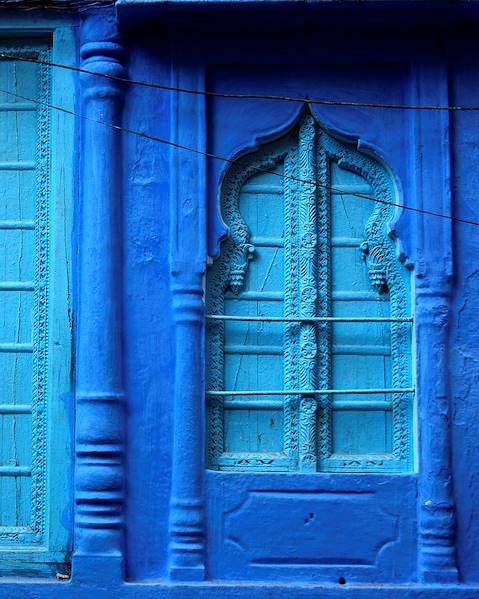Population
The Indian population is estimated at over one billion people and has overtaken China as the most populated country in the world. About 70% of people live in the countryside. Mumbai (previously Bombay) is the most populous city with around 12 million inhabitants, followed by Delhi (11 million), Bangalore (eight million) and Hyderabad (six million).
Official language
The Constitution of India recognises 22 official languages. The national language is Hindi (using the Devanagari alphabet), which is spoken by 45% of the population and used by the government. Hindi is most widely spoken in the north and is generally understood everywhere except in a handful of small southern states. English is spoken by educated members of the population, by traders, on tourist sites, hotels and universities. Regional accents in India are very diverse – just when you think you understand the locals well on your India holiday, you’ll hear a completely different linguistic take on the English language.
Languages spoken
There are many regional languages and a plethora of dialects.
People
The Indian population is made up of several thousand different ethnicities. Nevertheless, it can be divided into two major groups – the Indo-Aryans and the Dravidians. The Dravidians established the first Indian civilisation, the Indus. Today, the population of India is composed of 72% Indo-Aryans and 25% Dravidians along with many other minority groups.
Religion
While India is a secular state, religion plays a central part in the culture of the country. The most practised religions are Hinduism (79.8%), Islam (14.2%) and Christianity (2.3%). Buddhism, which is native to northern India, is mostly concentrated in the Himalayan region or near the Myanmar border and the branch practiced is generally Tibetan Buddhism. India is also home to many other minority faiths, such as Jainism, an ancient religion that teaches the achievement of bliss through nonviolence to all living creatures.
National Holiday
India is often branded as the ‘land of festivals’. Most bank holidays fall within the Indian lunar calendar or Buddhist, Muslim and Christian calendars, therefore dates change from year to year. However, some celebrations are fixed, for example: 25 December: Christmas. January 1: New Year's Day. January 26: Republic Day. May 11: Buddha Purnima. August 15: Independence Day. October 2: Anniversary of Mahatma Gandhi. November 4: Birthday Guru Nanak.
Holiday Calendar
Most holidays are religious, they outnumber calendar days and change dates every year. A few of the bigger, main events of India include:
- The Tamil New Year: January.
- New Year in Kerala: April.
- Holi, festival of colour: March.
- Dusserah, feast of gods: from September to October.
- Diwali, festival of lights: October-November.
Significant Muslim holidays include Ramadan and its end, Eid al-Adha and the Prophet's Birthday among many others.
History
The Indus civilisation, which reached its peak between 2500 and 1800 BC, was the first Indian civilisation, as evidenced by the discovery of remains of the ancient Indus city of Harappa in Punjab. It is still unknown exactly how the Indus civilisation collapsed, but the urban centres created by the Indus people slowly broke down until they were almost forgotten. In around 1800 BC the Aryans, who came from the Caspian Sea region, arrived and settled. During this time, Hinduism developed and the sacred religious texts, The Vedas, were created. The caste system was also reportedly introduced during the Aryan time of power. In 322 BC Chandragupta Maurya founded the Mauryan dynasty and conquered eastern and northern India. The power of the empire, during its pinnacle, extended over parts of current Iran and Afghanistan. The empire was a victim of its own success and ultimately paid for its vast size with collapse in 184 BC. Power scattered after its demise and at the beginning of the Christian era, the Kushan, from Central Asia, recreated a unity between the Indus and the Ganges. India prospered and trade flourished with the Roman Empire. Following the death of the Kushan emperor King Kanishka, the empire broke down and once again power was fragmented into smaller states. A new empire was formed, the Gupta Dynasty, in 320.
Under a new ruler, India was united and it blossomed – society was civilised, trade was stable and literature, poetry and astronomy thrived – many deem this period the country’s golden age. The Huns, a fierce, nomadic people, invaded India in the fifth century, but their victory was short-lived and they surged back in the next century, leaving India fragmented again. Various attempts to restore unity failed in the years that followed. From the tenth century, Muslim Turkish pressure defeated the Indian kingdoms and Delhi was conquered in 1193, and Varanasi (Benares) in 1194. In 1206, the Delhi Sultanate was created, which conquered large parts of Northern India. The first Sultan founded the Mamluk Dynasty (1206-1290), which was the first of five dynasties of the Delhi Sultanate. With the north under control, the Sultanate pushed south. Meanwhile a conqueror named Tamerlane appeared in the northwest (1398) and eventually ruined the Delhi sultanate of power. In 1498, Portuguese explorer Vasco da Gama landed on the Malabar Coast; the Portuguese occupied Goa in 1510. For Indians, the Mughal Empire is next to rise. Babur, a descendant of Tamerlane, captured Delhi in 1526 and laid the foundations for a new empire.
Among his successors, the most prominent was Akbar, arguably the greatest Mughal ruler, Akbar promoted understanding between Muslims and Hindus (those involved in the administration of the country). Great artistic achievements occurred under Akbar, including the building of the Red Fort of Agra. In the south, the Vijayanagar empire collapsed and the kingdoms that shared the spoils were gradually annexed by the Mughals. The decline of the Mughal Empire came in the form of the stubborn resistance of the Marathas in the south and Persian attacks in 1739. The empire continued on but was fading fast. Sikhs took over Punjab in 1799, but surrendered to the East India Company in 1849.
After a lengthy and much-resisted campaign across the country, in 1858, the British Empire took over the East India Company and the British Indian Empire was established. The English had a free hand to determine the last Indian empire: the British India or British Raj. Wielding a sword and economic power, playing divisions and alliances, the British ensured the control of the subcontinent. The first order of business was commercial interests for Britain through the East India Company and a market was formed. India benefitted and suffered all at once from the European Industrial Revolution. While the country modernised, the importation of English manufactured goods ruined local production, with textiles the worst affected. In the Act for Better Government of India in 1858, British power from the East India Company was transferred to the crown. Victoria was crowned Empress of India in 1876.
The first Indian nationalist party, the Congress Party, was founded in 1885 and the slow march towards independence began. The following decades were marked by two issues: the British withdrawal and relations between Hindus and Muslims, the latter of which created an organisation in 1906, the Muslim League. The First World War marked a time for growing nationalist feelings – one million soldiers of the Empire supported the war effort, but Britain was weakened by the war and a slow decline began.
The emergence of Mohandas Gandhi changed the game again. A lawyer, he rose to become the leader of India’s struggle for independence. Gandhi opposed violence and instead, launched a boycott of British textiles and schools. He was arrested in 1922 and jailed for two years. The ‘salt march’ in 1930, in which Ghandi led a peaceful process to end the government's monopoly of salt production, earned him worldwide fame. The notion of India’s independence was no longer an if but a when. In 1935, the Government of India Act gave formal autonomy to eleven Indian provinces. An unfortunate side effect to increased independence was the heightening of tensions between Hindus and Muslims. The Viceroy of India supported the British in World War II, but not the Congress Party, who, in 1942, demanded that the British leave India. After the war, the Direct Action Day Calcutta riots in 1946, which led to thousands of deaths, showed the depth of the rift between Hindus and Muslims. India became independent on 15 August 1947. This simultaneously created a Muslim state, Pakistan. This partition created a period of mass migration, where millions of people moved amidst a climate of great violence. Soon, the two countries clash in Kashmir. Gandhi, who paved the way for independence, was assassinated in January 1948. Activist Pandit Jawaharlal Nehru becomes India’s first Prime Minister.
On 26 January 1950, India officially becomes a republic. The caste system was abolished. The Indian republic spearheads a non-alignment policy to maintain sovereignty and oppose imperialism. Between 1964-1966 and in 1971, there are two new wars with Pakistan. The second, to the advantage of India, ended with the independence of Bangladesh. The reign of Indira Gandhi (1966-1977 and 1980-1984) tested the limits of Indian democracy – following two years of emergency rule in 1975, Gandhi led a campaign of forced sterilisation and the repression of Sikhs. After the assassination of Indira Gandhi in 1984, her son, Rajiv, succeeds her before his assassination in 1991. The 90s were marked by the deregulation of industry and a sharp growth in the economy, which boomed. Today, the economy and population of India continue to grow rapidly.
Policy
India is a federal constitutional republic consisting of 29 states and six union territories. The president has an honorary position. He is elected for a renewable five-year term by an electoral college consisting of both houses of parliament and the state legislatures. The real head of the executive is the Prime Minister, elected by the parliamentary majority. The legislative power is held by Parliament and consists of two chambers – the House of the People (Lok Sabha), called the ‘lower house’ is composed of 545 members elected for five years by national vote; the Council of States (Rajya Sabha), called the ‘upper house’, is composed of 245 members (of which eight are appointed by the president) elected by the state legislatures and their mandate is six years.
Famous Indians
- Mohandas Karamchand Gandhi (1869-1948). Widely know as Mahatma Gandhi (Mahatma meaning ‘great soul’), Gandhi was one of the founding fathers of modern India and the promoter of nonviolence in a revolutionary way.
- Jawaharlal Nehru (1889-1964). Another hero of the Indian independence struggle. If Gandhi was its soul and icon, Nehru was its engine. The first Prime Minister of independent India, Nehru initiated the policy of non-alignment, which was adopted by many countries from former colonial empires.
- Mother Teresa (1910-1997). With Albanian origin, Mother Teresa arrived in India in 1929. In 1947, she took Indian citizenship and in 1950, founded Calcutta's Missionaries of Charity. Dedicating her life to the sick and poor, Mother Teresa’s charity took care of anyone who had no one. Her absolute dedication was awarded the Nobel Peace Prize in 1979.
- Indira Gandhi (1917-1984). A politician and the first female Prime Minister of India. Gandhi was the only child of Jawaharlal Nehru. A strong personality, she was Prime Minister of the Indian Union from 1966 to 1977 and from 1980 to 1984. Violent tensions between Indians and Sikhs led to her eventual assassination.
- Rabindranath Tagore (1861-1941). A poet, novelist, playwright and philosopher, Tagore was the first Indian writer to have a real international audience. He wrote primarily in Bengali (sometimes reflecting his own lyrics in English). His work is a masterclass in mysticism and nature, but also included politics and debate. One of Tagore’s poems is the text for India’s national anthem and another is the anthem of Bangladesh. Tagore won the Nobel Prize for literature in 1913. His most famous works include a poetry collection, The Lyrical Offering (1910), and novel, The Home and the World (1916).
- Ravi Shankar (born 1920). A sitar master and composer. After a long traditional initiation, Shankar brought Indian music to the world stage. His influence is noticeable on such diverse artists as Yehudi Menuhin, Philip Glass, John Coltrane, George Harrison and Brian Jones.
- Satyajit Ray (1921-1992). A director and screenwriter who made over 30 films, many questioning the relationship that traditional India has with modernity.
Etiquette
India is a secular state, but traditions and customs govern everyday life, and there are a handful of things to be aware of to ensure a stress-free trip.
Tight or revealing clothing should be avoided, including short skirts, short and sleeveless tops. Make sure to remove shoes at the entrance to holy places. In many religious buildings, it is mandatory to cover arms and legs and occasionally heads will also need to be covered, especially in Sikh temples. Before visiting the Jain temples, you will be asked to remove any leather. Do not touch the representations of deities and ask permission before taking photos of any religious places, ceremonies or people.
Access to the Taj Mahal is strictly controlled – there are separate male and female entrances, searches and you’re not allowed to carry tobacco, food or electronic devices (except a camera and mobile phone). Lockers are available to visitors. Such small measures are only a short diversion to a visit to the ‘Crown Palace’ – an astounding feat of architecture.
Generally, the left hand is considered unclean and you should avoid using it when eating or giving money or objects to others. Most Indians remove their shoes upon arriving at their homes, so follow their lead if you have received the honour of a dinner invitation.
Do not touch the head of an Indian child or adult. Do not point the soles of your feet towards anything and be careful not to touch an Indian with your feet. In contrast, touching someone's feet with your hands is considered a mark of great respect and many beggars will do this when asking for money.
Shopping
Indian craftsmanship offers such a richness of quality and variety that it can be very difficult to narrow down your purchases in order for you to be able to cram them into your suitcase. On the street or in markets, haggling is a must and is all part of the fun of the purchasing process. If you’re not one for bartering, cooperatives and official stores (emporiums) have fixed prices. Many also offer beautiful goods from different parts of the country, so you can acquire a full range of Indian mementos from all over. Indian carpets and textiles are among the finest in the world – the biggest region for carpet production is Kashmir, where there’s something for everyone, in every budget and made from a plethora of materials, including wool, silk, silk-wool blends and cotton. In textiles, the choice is as endless as there are techniques and styles of making them – gorgeous silk shawls with gold threads, warm wool wraps, silk and cotton blends decorated with intricate motifs and bright fabrics adorned with mirrors and embroidery. Saris, in all their stunning colour and variance, are impossible to miss – expertly draped without pins or seams, there are ordinary styles and more elaborate, ceremony designs.
Local tailors are also worth a visit – the quality and beauty of fabrics create tailored works of art that often defy their price tag. Jewellery is also magnificent in India, gold is queen here and the most famous pieces come from Rajasthan. Kerala and Tamil Nadu also hold a treasure trove of pieces. Precious stones and semi-precious stones are popular tourist purchases. Hyderabad is one of the world centres of glass beads. The Indians also excel in metalworking, with copper and bronze used to create masterful figurines and votive statuettes. Woodworking is another Indian specialty – whether it’s walnut furniture from Kashmir or sandalwood statuettes from Karnataka, each region uses wood to develop its own craft. And if that’s not enough, there are also excellent leather goods (sandals, shoes, bags and the like), musical instruments and small items that your curiosity will uncover like sandalwood soaps, perfumes, incense, spices of all kinds, religious objects and charming papier-mâché keepsakes.
Food
With countless dishes that defy the imagination, Indian cuisine is some of the best in the world. Simply put, Southern Indian cooking, which uses rice as its base, tends to be vegetarian and spicier. This makes plenty of room for meats, including lamb, goat and chicken in the northern reaches. Wheat is also the grain of choice in the north, making various breads, including chapati, paratha, puti and the full range of naan, a mainstay. A common point of difference is the masala spice mixture where culinary creativity really comes into play. Exact recipes are often well-kept secrets and there are more than a dozen spices to develop the masala spice mix. Among these are: turmeric, saffron, cardamom, ginger, coriander, nutmeg, cumin, poppy seeds, allspice, cinnamon, cloves, pepper, anise and this list far from exhaustive. While many spicy Indian dishes are deadly for sensitive palates, there are just as many that are sweet and fragrant. The most common dish in India is probably the dhal. A delicious dish made with split lentils and served in support of other dishes or as the main course. Another speciality is the curry, and in India the word refers to any spicy stew. Curries come in all shapes and forms – meat curries, fish, seafood or vegetable. The flavour is always impactful and if a spicy curry is served, dishes served alongside are milder.
Another favourite is biryani rice mixed with saffron and meat cooked in a clay oven, the tandoor. This cooking method, brought to India by the Mughal Muslim, gave birth to Mughlai cuisine, popular in North India. When cooking tandoori-style, the main specialties are meats and spicy pickled fish, but Mughal also introduced skewered kebab dishes to India. Another meal with foreign origins is pork vindaloo marinated in vinegar – a Portuguese specialty of Goa. Dosas, pancakes made from a mixture of fermented rice and lentils, plain or stuffed vegetables, are one of the basics of vegetarian food in southern India. Dairy is used a lot in cooking, too – paneer is a fresh cheese used in a variety of ways. Dahi, a traditional yoghurt, and raita, a cool, minty chutney, are often served with vegetables, fruits or spices as an accompaniment. Various condiments are enjoyed, including pickles and chutneys, which can have flavours that really pack a punch. When it comes to the sweet stuff, India certainly knows how to deliver on that front too – delicious ice cream, kulfi, is a fruity joy, then there are springy dough balls and sweet rice pudding. Fans of fresh fruit will relish the Indian banquet on offer – mangoes, papayas, guavas, bananas, pineapples, apples, apricots, strawberries are available in abundance. At the end of a meal, many Indians chew a paan – a betel leaf rolled up with a mixture of spices and herbs. The paan is famous for its digestive properties, but can upset the western traveller. Enjoying Indian cuisine is a way to understand the beating heart of the country.
Drink
Tap water isn’t recommended, so it’s best to keep stocked up with bottled water and refrain from ice. To help aid plastic waste, we would encourage travellers to opt for reusable filter bottles. India’s national drink is tea (chai). Real Indian tea is always prepared with milk, tastes very sweet and is flavoured with spices (cardamom, ginger). Indians drink a lot of coffee too, also milky and very sweet. Soft drinks are available at every turn, with a multitude of fresh fruit juices available.
The lassi is another Indian favourite – its formulation is based on yoghurt and can be drunk naturally, sweetened or flavoured with fruit or spices. Alcohol is prohibited in some holy cities and tightly regulated in certain areas, or during religious festivals. Indian beer is good and local brands you’ll see are Kingfisher, Haywards and Godfather. Unregulated alcohol has been linked to deaths, so it’s strongly recommended that only drinks purchased from distilleries are consumed. India also produces a very sweet wine in Goa on the Karnataka plateau.

















